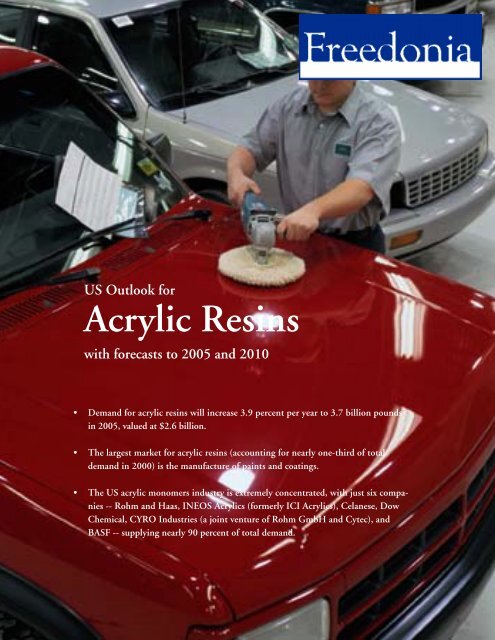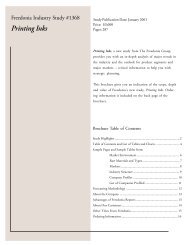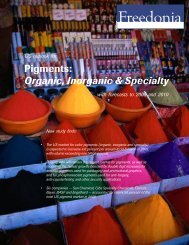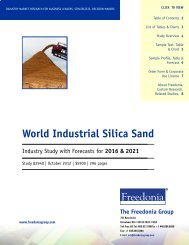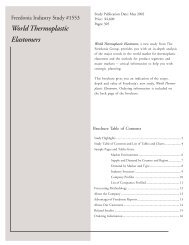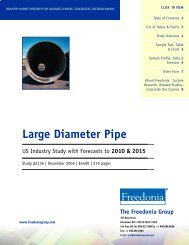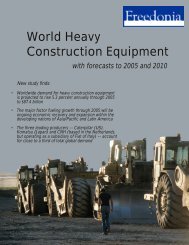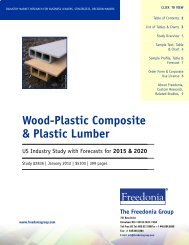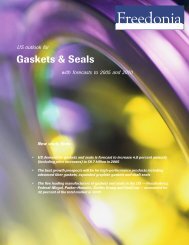Acrylic Resins - The Freedonia Group
Acrylic Resins - The Freedonia Group
Acrylic Resins - The Freedonia Group
Create successful ePaper yourself
Turn your PDF publications into a flip-book with our unique Google optimized e-Paper software.
US Outlook for<br />
<strong>Acrylic</strong> <strong>Resins</strong><br />
with forecasts to 2005 and 2010<br />
• Demand for acrylic resins will increase 3.9 percent per year to 3.7 billion pounds<br />
in 2005, valued at $2.6 billion.<br />
• <strong>The</strong> largest market for acrylic resins (accounting for nearly one-third of total<br />
demand in 2000) is the manufacture of paints and coatings.<br />
• <strong>The</strong> US acrylic monomers industry is extremely concentrated, with just six companies<br />
-- Rohm and Haas, INEOS <strong>Acrylic</strong>s (formerly ICI <strong>Acrylic</strong>s), Celanese, Dow<br />
Chemical, CYRO Industries (a joint venture of Rohm GmbH and Cytec), and<br />
BASF -- supplying nearly 90 percent of total demand.
<strong>Freedonia</strong> Industry Study #1492<br />
<strong>Acrylic</strong> <strong>Resins</strong><br />
Study Publication Date: December 2001<br />
Price: $3,600<br />
Pages: 237<br />
<strong>Acrylic</strong> <strong>Resins</strong>, a new study from <strong>The</strong> <strong>Freedonia</strong> <strong>Group</strong>,<br />
provides you with an in-depth analysis of major trends in<br />
the industry and the outlook for product segments and<br />
major markets -- critical information to help you with<br />
strategic planning.<br />
This brochure gives you an indication of the scope, depth<br />
and value of <strong>Freedonia</strong>'s new study, <strong>Acrylic</strong> <strong>Resins</strong>. Ordering<br />
information is included on the back page of the<br />
brochure.<br />
Brochure Table of Contents<br />
Study Highlights ............................................................................... 2<br />
Table of Contents and List of Tables and Charts ............................. 4<br />
Sample Pages and Sample Tables from:<br />
Market Environment .................................................... 6<br />
Acrylates and Methacrylates ......................................... 7<br />
Markets........................................................................ 8<br />
Industry Structure ........................................................ 9<br />
Company Profiles ...................................................... 10<br />
List of Companies Profiled ........................................ 11<br />
Forecasting Methodology ............................................................... 12<br />
About the Company ....................................................................... 13<br />
Advantages of <strong>Freedonia</strong> Reports ................................................... 13<br />
About Our Customers .................................................................... 14<br />
Other Titles From <strong>Freedonia</strong> ......................................................... 15<br />
Ordering Information..................................................................... 16
2<br />
Study Highlights<br />
<strong>Acrylic</strong> <strong>Resins</strong> #1492<br />
• Demand for acrylic resins will increase 3.9 percent<br />
per year to 3.7 billion pounds in 2005, valued at<br />
$2.6 billion.<br />
• While methacrylates will continue to account for the<br />
majority of acrylic resins demand, acrylates will<br />
record more rapid growth through 2005, the result of<br />
the latter's lower level of dependence upon highly<br />
cyclical markets, such as transportation equipment<br />
and construction.<br />
• <strong>The</strong> largest market for acrylic resins (accounting for<br />
nearly one-third of total demand in 2000) is the<br />
manufacture of paints and coatings.<br />
• <strong>The</strong> plastics industry will record above-average<br />
growth in demand, as the number of applications<br />
grows for polymer property modifiers.<br />
• <strong>The</strong> US acrylic monomers industry is extremely<br />
concentrated, with just six companies -- Rohm and<br />
Haas, INEOS <strong>Acrylic</strong>s (formerly ICI <strong>Acrylic</strong>s),<br />
Celanese, Dow Chemical, CYRO Industries (a joint<br />
venture of Rohm GmbH and Cytec), and BASF -supplying<br />
nearly 90 percent of total demand.<br />
<strong>Freedonia</strong> Industry Study
Study Highlights<br />
<strong>Acrylic</strong> <strong>Resins</strong> Demand<br />
(million pounds)<br />
% Annual Growth<br />
Item 1995 2000 2005 2010 00/95 05/00<br />
Gross Domestic Product (bil 1996$) 7544 9224 10550 12100 4.1 2.7<br />
lbs acrylic/mil $ GDP 323 330 349 370 -- --<br />
<strong>Acrylic</strong> <strong>Resins</strong> Demand<br />
By Monomer:<br />
2437 3042 3685 4475 4.5<br />
SUMMARY TABLE<br />
3.9<br />
Methacrylates 1259 1626 1945 2330 5.2 3.6<br />
Acrylates 1178 1416 1740 2145 3.7 4.2<br />
By Market:<br />
Paints & Coatings 804 986 1200 1465 4.2 4.0<br />
Construction 352 443 515 605 4.7 3.1<br />
Plastics 237 311 395 490 5.6 4.9<br />
Textiles & Fibers 249 269 305 350 1.6 2.5<br />
Industrial & Commercial 179 258 310 370 7.6 3.7<br />
Adhesives 177 227 280 345 5.1 4.3<br />
Paper & Paperboard 123 156 200 260 4.9 5.1<br />
Other Markets 316 392 480 590 4.4 4.1<br />
$/lb 0.62 0.64 0.70 0.76 0.6 1.8<br />
<strong>Acrylic</strong> <strong>Resins</strong> Demand (mil $) 1509 1946 2580 3380 5.2 5.8<br />
© Copyright by <strong>The</strong> <strong>Freedonia</strong> <strong>Group</strong>, Inc.<br />
<strong>Acrylic</strong> <strong>Resins</strong> Demand by Monomer,<br />
1995 Versus 2000<br />
(million pounds)<br />
2000<br />
1500<br />
1000<br />
500<br />
0<br />
Acrylates Methacrylates<br />
<strong>Acrylic</strong> <strong>Resins</strong> #1492 Order form on last page<br />
1995<br />
2000<br />
3
4<br />
List of Contents,<br />
Tables and Charts<br />
I. EXECUTIVE SUMMARY<br />
Summary Table ................................................................ 3<br />
II. MARKET ENVIRONMENT<br />
General .......................................................................... 4<br />
Macroeconomic Environment .............................................. 5<br />
Table - Macroeconomic Indicators .................................... 7<br />
Consumer Spending Trends ................................................ 7<br />
Table - Consumer Spending Activity................................ 9<br />
Demographic Trends ........................................................... 9<br />
Table - Demographic Indicators .....................................11<br />
Manufacturing Outlook .....................................................11<br />
Table - Manufacturers’ Shipments ..................................14<br />
Historical Trends ................................................................14<br />
Table - <strong>Acrylic</strong> <strong>Resins</strong> Historical Trends ..........................16<br />
Chart - <strong>Acrylic</strong> <strong>Resins</strong> Historical Trends ..........................16<br />
Technology ........................................................................17<br />
Production Processes .......................................................18<br />
Polymerization Processes .................................................21<br />
Feedstocks.......................................................................23<br />
Table - Feedstocks Consumption ................................26<br />
Environmental & Regulatory Considerations .....................26<br />
Environmental Factors ....................................................27<br />
Health Factors .................................................................27<br />
Recycling ........................................................................29<br />
Pricing Considerations ........................................................30<br />
Table - <strong>Acrylic</strong> <strong>Resins</strong> Pricing ..........................................31<br />
Acrylates ........................................................................31<br />
Methacrylates..................................................................32<br />
Foreign Trade .....................................................................33<br />
Table - Foreign Trade in <strong>Acrylic</strong> <strong>Resins</strong> ..........................34<br />
International Activity ..........................................................35<br />
Acrylates ........................................................................35<br />
Methacrylates..................................................................36<br />
III. ACRYLIC RESIN MARKETS<br />
General ........................................................................37<br />
Table - <strong>Acrylic</strong> <strong>Resins</strong> Markets ........................................38<br />
Chart - <strong>Acrylic</strong> <strong>Resins</strong> Markets, 2000..............................39<br />
Paints & Coatings ..............................................................39<br />
Paints & Coatings Outlook.............................................39<br />
Table - Paints & Coatings Shipments .........................41<br />
<strong>Acrylic</strong> <strong>Resins</strong> Demand ...................................................42<br />
Table - Paints & Coatings Markets for <strong>Acrylic</strong> <strong>Resins</strong> ....44<br />
Construction ......................................................................44<br />
Construction Overview...................................................45<br />
Table - Construction Activity .....................................46<br />
<strong>Acrylic</strong> <strong>Resins</strong> Demand ...................................................46<br />
Table - Construction Markets for <strong>Acrylic</strong> <strong>Resins</strong> ..........48<br />
Plastics ........................................................................48<br />
Plastics Industry Overview ..............................................48<br />
Table - Plastics Supply & Demand .............................50<br />
<strong>Acrylic</strong> <strong>Resins</strong> Demand ...................................................50<br />
Table - Plastics Markets for <strong>Acrylic</strong> <strong>Resins</strong> ...................52<br />
Textiles & Fibers ................................................................53<br />
Textile & Fiber Products Overview ................................53<br />
Table - Textile & Fiber Industry Indicators ................54<br />
<strong>Acrylic</strong> <strong>Resins</strong> Demand ...................................................54<br />
Table - Textiles & Fibers Markets for <strong>Acrylic</strong> <strong>Resins</strong> ...55<br />
Industrial & Commercial ....................................................56<br />
Retail Sales Outlook ........................................................56<br />
Table - Retail Sales ......................................................58<br />
<strong>Acrylic</strong> <strong>Resins</strong> Demand ...................................................58<br />
Table - Industrial & Commercial<br />
Markets for <strong>Acrylic</strong> <strong>Resins</strong> .........................................59<br />
Adhesives & Sealants ..........................................................60<br />
Adhesives & Sealants Overview ......................................60<br />
Table - Adhesives & Sealants Production ....................61<br />
<strong>Acrylic</strong> <strong>Resins</strong> Demand ...................................................61<br />
Table - Adhesives & Sealants Markets for <strong>Acrylic</strong> <strong>Resins</strong> ....63<br />
Transportation Equipment .................................................63<br />
Transportation Markets Overview ..................................64<br />
Table - Transportation Equipment Shipments ...........65<br />
<strong>Acrylic</strong> <strong>Resins</strong> Demand ...................................................65<br />
Table - Transportation Equipment<br />
Markets for <strong>Acrylic</strong> <strong>Resins</strong> .........................................66<br />
Paper & Paperboard ...........................................................67<br />
Paper & Paperboard Overview .......................................67<br />
Table - Paper & Paperboard Production .....................68<br />
<strong>Acrylic</strong> <strong>Resins</strong> Demand ...................................................68<br />
Table - Paper & Paperboard Markets for <strong>Acrylic</strong> <strong>Resins</strong> ...69<br />
Consumer Products ............................................................70<br />
Table - Consumer Products Markets for <strong>Acrylic</strong> <strong>Resins</strong> ...71<br />
Other Markets ....................................................................71<br />
Table - Other Markets for <strong>Acrylic</strong> <strong>Resins</strong> .........................73<br />
<strong>Acrylic</strong> <strong>Resins</strong> #1492 <strong>Freedonia</strong> Industry Study
IV. ACRYLATES<br />
General ........................................................................74<br />
Acrylates Producers & Capacity ..........................................75<br />
Table - Acrylates Capacity by Producer, 2000 ................77<br />
Chart - Acrylates Esters Capacity by Producer, 2000 ......78<br />
Acrylates Supply & Demand ..............................................78<br />
Table - Acrylates Supply & Demand ..............................80<br />
Acrylates Demand by Type ................................................80<br />
Table - Acrylates Demand by Type ................................81<br />
Chart - Acrylates Demand by Type, 2000 .....................81<br />
Butyl Acrylate ...............................................................82<br />
Table - Butyl Acrylate Demand ..................................83<br />
Ethyl Acrylate ...............................................................83<br />
Table - Ethyl Acrylate Demand ..................................84<br />
Ethylhexyl Acrylate.......................................................85<br />
Table - Ethylhexyl Acrylate Demand ..........................86<br />
Other Acrylates .............................................................86<br />
Table - Other Acrylates Demand ................................88<br />
Acrylates Markets ................................................................88<br />
Table - Acrylates Demand by Market .............................89<br />
Chart - Acrylates Demand by Market, 2000 ...................89<br />
Paints & Coatings ...........................................................90<br />
Table - Paints & Coatings Markets for Acrylates .........93<br />
Textiles & Fibers ............................................................93<br />
Table - Textiles & Fibers Markets for Acrylates ...........95<br />
Adhesives ........................................................................95<br />
Table - Adhesives & Sealants Markets for Acrylates .....97<br />
Paper & Paperboard .......................................................97<br />
Table - Paper & Paperboard Markets for Acrylates ......98<br />
Plastics ........................................................................99<br />
Table - Plastics Markets for Acrylates ........................ 101<br />
Other Markets ............................................................. 101<br />
Table - Other Markets for Acrylates ......................... 103<br />
V. METHACRYLATES<br />
General ..................................................................... 104<br />
Methacrylates Producers & Capacity ............................... 104<br />
Table - Methacrylates Capacity by Producer, 1998 ..... 107<br />
Chart - Methacrylates Capacity by Producer, 2000 ..... 107<br />
Methacrylates Supply & Demand ................................... 108<br />
Table - Methacrylates Supply & Demand ................... 109<br />
Methacrylates Demand by Type ..................................... 109<br />
Table - Methacrylates Demand by Type ..................... 110<br />
Methyl Methacrylate ................................................... 110<br />
Table - Methyl Methacrylate Supply & Demand .... 113<br />
Other Methacrylates .................................................... 113<br />
Table - Other Methacrylates Supply & Demand ..... 114<br />
Chart - Other Methacrylates Demand by Type, 2000 ... 115<br />
<strong>Acrylic</strong> <strong>Resins</strong> #1492<br />
Butyl Methacrylate .................................................. 115<br />
Lauryl Methacrylate ................................................. 117<br />
Stearyl Methacrylate ................................................. 117<br />
Isobutyl Methacrylate .............................................. 118<br />
Glycidyl Methacrylate .............................................. 118<br />
Ethyl Methacrylate .................................................. 119<br />
Miscellaneous Methacrylates .................................... 120<br />
Methacrylates Markets ..................................................... 122<br />
Table - Methacrylates Demand by Market .................. 123<br />
Chart - Methacrylates Markets, 2000 .......................... 123<br />
Construction ............................................................... 124<br />
Table - Construction Markets for Methacrylates ...... 125<br />
Paints & Coatings ........................................................ 126<br />
Table - Paints & Coatings Markets for Methacrylates 127<br />
Industrial & Commercial ............................................. 127<br />
Table - Industrial & Commercial<br />
Markets for Methacrylates ...................................... 129<br />
Plastics ..................................................................... 129<br />
Table - Plastics Markets for Methacrylates ................ 130<br />
Transportation Equipment .......................................... 130<br />
Table - Transportation Equipment<br />
Markets for Methacrylates ...................................... 132<br />
Adhesives & Sealants ................................................... 132<br />
Table - Adhesives & Sealants<br />
Markets for Methacrylates ...................................... 133<br />
Consumer Products ..................................................... 133<br />
Table - Consumer Product Markets for Methacrylates .. 135<br />
Other Markets ............................................................. 136<br />
Table - Other Markets for Methacrylates.................. 139<br />
VI. INDUSTRY STRUCTURE<br />
General ..................................................................... 140<br />
Industry Concentration & Market Share ......................... 140<br />
Chart - <strong>Acrylic</strong> <strong>Resins</strong> Market Share, 2000 .................. 142<br />
Acrylates ..................................................................... 143<br />
Chart - Acrylates Market Share, 2000 ...................... 144<br />
Methacrylates............................................................... 145<br />
Chart - Methacrylates Market Share, 2000 .............. 146<br />
Industry Restructuring .................................................... 146<br />
Table - Selected Acquisitions & Divestitures ................ 148<br />
Cooperative Agreements .................................................. 151<br />
Table - Selected Cooperative Agreements ..................... 152<br />
Marketing & Distribution ............................................... 154<br />
Research & Development ................................................ 156<br />
Competitive Strategies ..................................................... 158<br />
Company Profiles .....................................................160-237<br />
Order form on last page<br />
5
6<br />
Market Environment<br />
<strong>The</strong> Market Environment Section<br />
discusses factors influencing acrylic<br />
resin demand, including technology<br />
and environmental considerations.<br />
This information provides you with an<br />
understanding and an analysis of the<br />
climate in which the acrylic resins<br />
industry operates.<br />
<strong>Acrylic</strong> <strong>Resins</strong> #1492<br />
Feedstocks<br />
MARKET ENVIRONMENT<br />
Demand for raw materials used in the manufacture of acrylic monomers will<br />
expand 3.8 percent per year to 4.4 billion pounds in the year 2005. Raw material<br />
feedstocks utilized SAMPLE in the production PAGEof<br />
acrylic resins consist primarily of acetone<br />
and hydrogen cyanide (to produce methacrylates), acrylic acid (to produce<br />
acrylates) and a range of monohydric alcohols with which the feedstocks are<br />
reacted to produce the various acrylic monomers. Other chemicals, while not<br />
feedstocks, are also utilized, including catalysts and sulfuric acid. In general, the<br />
feedstocks and other necessary chemicals required for acrylic resins production are<br />
widely available and in adequate supply.<br />
Back-integration into raw materials is commonplace in the acrylates sector of the<br />
industry, with all four producers operating acrylic acid production facilities. In<br />
addition, three of the four manufacture at least some of the alcohols required for<br />
acrylics production. In methacrylates, however, the situation is markedly<br />
different. Apart from Rohm and Haas, which produces its own hydrogen cyanide,<br />
methacrylate producers must purchase their raw material requirements on the<br />
merchant market. Overall, Dow Chemical is the most back-integrated, with inhouse<br />
production of acrylic acid, ethanol, butanol, ethylhexanol and isopropanol.<br />
<strong>The</strong> supply of monohydric alcohols for use in acrylic resin manufacture is more<br />
than adequate, and there are a number of different sources for these products. <strong>The</strong><br />
principal alcohols used in the manufacture of acrylic resins are methanol, butanol,<br />
ethanol and ethylhexanol. <strong>The</strong> supply of methanol and ethanol is not expected to<br />
be a problem, since acrylics production represents a comparatively small end use.<br />
With respect to butanol and ethylhexanol, however, the situation is different since<br />
acrylics manufacture represents a significant outlet for both alcohols.<br />
Acetone is the largest volume feedstock used in the manufacture of methacrylates,<br />
specifically methyl methacrylate. Unlike acrylates, which all begin with acrylic<br />
<strong>Freedonia</strong> Industry Study
Acrylates & Methacrylates<br />
<strong>The</strong>se Sections provide demand for<br />
historical years and forecast growth to<br />
2005 and 2010.<br />
This information helps you:<br />
• Analyze your company's<br />
growth potential in<br />
the industry.<br />
• Outline your strategic<br />
plans for five and ten<br />
years out.<br />
• Establish sales goals.<br />
Acrylates Demand by Type - Ethyl Acrylate<br />
ACRYLATES<br />
Demand for ethyl acrylate will advance 3.8 percent per year to 315 million pounds<br />
SAMPLE PAGE<br />
in the year 2005, valued at $200 million. Gains will result from increasing use in<br />
paints and coatings, as well as its growing use as an intermediate in specialty<br />
polymers, such as ethylene ethyl acrylate (EAA). Ethyl acrylate, which is slightly<br />
less expensive than butyl acrylate, imparts a moderately higher level of abrasion<br />
resistance to the end product and is thus frequently used in conjunction with butyl<br />
acrylate.<br />
Producers of ethyl acrylate include BASF, Celanese, Dow Chemical and Rohm and<br />
Haas, all of whom are back-integrated into acrylic acid. Celanese is primarily a<br />
merchant marketer, while the others all use some of their production captively.<br />
Allchem and Ashland Chemical also market ethyl acrylate in the US.<br />
Methyl Methacrylate Supply & Demand<br />
Ethylhexyl Acrylate<br />
(million pounds)<br />
Demand for ethylhexyl acrylate will increase 3.2 percent annually to 145 million<br />
pounds in the year 2005, valued at $100 million. Gains will result primarily from<br />
Item the increased production of 1990 paints and 1995 coatings. 2000 In particular, 2005 ethylhexyl 2010 acrylate<br />
is used in automotive clearcoats. In addition to being the acrylic base resin in<br />
Methyl Methacrylate Production automotive clearcoats, ethylhexyl 1050 acrylate 1241 also 1510 helps to 1780 protect the 2100 finish from<br />
+ imports<br />
damage and fading caused by ultraviolet (UV) rays.<br />
3 38 45 55 60<br />
- exports 125 155 90 80 60<br />
Ethylhexyl acrylate is somewhat more specialized SAMPLE than either TABLE butyl or ethyl<br />
Methyl Methacrylate Demand acrylate. <strong>The</strong> relatively low 928 level of 1124 production 1465 eliminates 1755 economies 2100 of scale, so<br />
PMMA Sheet that selling prices for ethylhexyl 331 acrylate 418 are higher 573 than 675 other commodity 800<br />
PMMA Molding & Powder acrylates. <strong>Resins</strong><br />
Other Polymer Forms<br />
162<br />
435<br />
197<br />
509<br />
255<br />
637<br />
305<br />
775<br />
365<br />
935<br />
$/lb<br />
Manufacturers of ethylhexyl acrylate include BASF, Celanese and Dow Chemical.<br />
0.48 0.68 0.65 0.72 0.77<br />
Methyl Methacrylate Demand (mil $) 445 764 952 1265 1620<br />
% methyl methacrylate 88.7 89.3 90.1 90.2 90.1<br />
Methacrylates Demand (mil lbs) 1046 1259 1626 1945 2330<br />
© Copyright by <strong>The</strong> <strong>Freedonia</strong> <strong>Group</strong>, Inc.<br />
<strong>Acrylic</strong> <strong>Resins</strong> #1492 Order form on last page<br />
7
8<br />
Markets<br />
<strong>The</strong> Markets Section analyzes trends<br />
and considers the threats and<br />
opportunities in each of the major<br />
markets for acrylic resins.<br />
<strong>The</strong> information presented will<br />
help you:<br />
• Focus your sales and marketing<br />
efforts on high growth areas.<br />
• Propose new areas for development.<br />
<strong>Acrylic</strong> <strong>Resins</strong> #1492<br />
Industrial & Commercial - <strong>Acrylic</strong> <strong>Resins</strong> Demand<br />
ACRYLIC RESIN MARKETS<br />
Demand for acrylic resins in industrial and commercial markets will increase 3.7<br />
percent annually to 310 million pounds in the year 2005. Demand in these<br />
applications is accounted SAMPLE for entirely PAGE by methacrylates, which are consumed in the<br />
form of polymethyl methacrylate (PMMA) sheet and molding resins. Commercial<br />
applications (retail signage) will record more rapid growth, as the clarity, toughness<br />
and competitive cost of acrylic signage boosts market penetration. Industrial<br />
applications will record more modest growth, reflective of slowing growth in<br />
industrial production.<br />
In commercial markets, PMMA sheet products manufactured from methyl<br />
methacrylate are expected to continue to take market share from wood and neon<br />
signs due to their superior protection against the elements, vandalism and other<br />
damage. In addition, back-lit acrylic signage is becoming the dominant choice for<br />
free-standing signs which are designed primarily to increase the visibility of a range<br />
of retail and commercial establishments. Apart from exterior signage, commercial<br />
applications also include point-of-sale (POS) advertising, poster boxes (eye level<br />
advertising fixtures mounted in transit stations and shopping malls) and other<br />
advertising displays.<br />
Plastic Markets for <strong>Acrylic</strong> <strong>Resins</strong> by Monomer & Application<br />
(million pounds) In industrial segments of the market, products include goggles, face plates,<br />
Item<br />
equipment housings and screens. <strong>The</strong>se products shield workers from the moving<br />
1990 1995 2000 2005 2010<br />
parts of industrial machinery or from other workplace hazards, such as flying<br />
Plastics Production (bil shreds lbs) of debris or extreme 62.0 heat. Competing 78.7 materials 98.8 include 118.5 polycarbonate 139.8 and<br />
lbs acrylics/000 lbs plastic polyethylene terephthalate 2.8 (PET), although 3.0 acrylics 3.1 generally 3.3 maintain 3.5 a<br />
competitive advantage over polycarbonate in price, while PET products are more<br />
<strong>Acrylic</strong> <strong>Resins</strong> in Plastics or less limited to light duty 172 applications. 237 SAMPLE 311 TABLE 395 490<br />
By Monomer:<br />
Acrylates 64 92 122 155 190<br />
Methacrylates 108 145 189 240 300<br />
By Application:<br />
Property Modifiers 114 159 211 270 340<br />
Co-Monomers 58 78 100 125 150<br />
% plastics 8.7 9.7 10.2 10.7 10.9<br />
<strong>Acrylic</strong> <strong>Resins</strong> Demand 1971 2437 3042 3685 4475<br />
© Copyright by <strong>The</strong> <strong>Freedonia</strong> <strong>Group</strong>, Inc.<br />
<strong>Freedonia</strong> Industry Study
Industry Structure<br />
Sample page from<br />
<strong>Freedonia</strong> Industry Study<br />
Gain #1117 a better Fractional understanding Horsepower of your Motors<br />
competition and analyze your<br />
company's position in the industry with<br />
information about:<br />
• industry composition & market share<br />
• competitive strategies<br />
• industry restructuring<br />
• marketing & distribution<br />
• research & development<br />
• cooperative agreements<br />
Research & Development<br />
INDUSTRY STRUCTURE<br />
As in most chemicals and plastics businesses, research and development efforts are<br />
an important part of any competitor’s acrylics business. By and large, research<br />
efforts have focused on the development of new products, with improved<br />
performance characteristics or wider application. In addition, a number of<br />
companies have expanded their research and development efforts in order to widen<br />
their product lines.<br />
SAMPLE PAGE<br />
<strong>The</strong> primary area of research has been the development of new products. For<br />
example, a number of producers have developed methyl methacrylates which are<br />
resistant to gamma radiation (for medical devices), ultraviolet stable grades (for<br />
construction products) and specialized emulsions and suspensions (for coatings and<br />
adhesives manufacture).<br />
Additionally, companies have moved to expand their technological reach through<br />
the licensing of production methods which lower manufacturing costs and/or reduce<br />
environmental problems. For example, several Japanese producers (particularly<br />
Asahi and Nippon Shokubai) license their methyl methacrylate processes<br />
worldwide, although these processes are not yet in use in the US.<br />
Asahi Chemical has developed a process through which methyl methacrylate is<br />
manufactured via direct esterification. Asahi Chemical is currently the only<br />
producer in the world using this process, at a 135-million- pound-per-year plant in<br />
Kawasaki, Japan. <strong>The</strong> plant, which has been in operation since early 1999, will<br />
soon be expanded to 220 million pounds. <strong>The</strong> process is expected to decrease<br />
costs related to building MMA plants. A 65- million-pound-per-year facility,<br />
which uses the acetone cyanohydrin process, has been closed.<br />
Shell has developed a process for manufacturing methyl methacrylates (and other<br />
methacrylates) which uses methylacetylene and propadiene as feedstocks. <strong>The</strong><br />
<strong>Acrylic</strong> <strong>Resins</strong> #1492 Order form on last page<br />
9
Company Profiles<br />
<strong>The</strong> Profiles Section analyzes 40<br />
companies active in the U.S. acrylic<br />
resins market. <strong>The</strong>se profiles represent<br />
a sampling or cross-section of the types<br />
of companies involved in the industry.<br />
Divisions, subsidiaries, joint<br />
ventures, etc., are discussed under<br />
appropriate parent companies.<br />
Sources for profiles included:<br />
• Information provided by<br />
key staff members in the<br />
respective companies<br />
• Annual reports<br />
• 10-K reports<br />
• Security analysts reports<br />
• Corporate product literature<br />
<strong>Acrylic</strong> <strong>Resins</strong> #1492<br />
10<br />
Cytec Industries Incorporated<br />
Five Garret Mountain Plaza<br />
West Paterson, NJ 07424<br />
973-357-3100<br />
http://www.cytec.com<br />
COMPANY PROFILES<br />
Cytec is a vertically integrated industrial chemicals company which operates in<br />
four segments: Water and Industrial Process Chemicals, Specialty Materials,<br />
Performance Products and Building Block Chemicals. Cytec’s 2000 sales totaled<br />
$1.5 SAMPLE billion, of which PAGE sales to the million. <strong>The</strong> Company employed 4,800 in<br />
2000.<br />
<strong>The</strong> Company is involved in the US acrylic resins industry through the Building<br />
Block Chemicals, Water and Industrial Process Chemicals, and Performance<br />
Products segments, as well as through the CYRO Industries joint venture. Through<br />
the Building Block Chemicals segment, Cytec manufactures such chemical<br />
intermediates as acrylonitrile, acrylamide, hydrocyanic acid, melamine and sulfuric<br />
acid for internal consumption as well as sale to the merchant market. <strong>The</strong>se raw<br />
materials are produced primarily at a facility in Fortier, Louisiana.<br />
As of 2000, the Building Block Chemicals segment had a capacity for 475 million<br />
pounds of acrylonitrile annually. Approximately 25 percent of the segment’s<br />
acrylonitrile is designated for captive use by Cytec for the production of<br />
acrylamide. An estimated 40 percent of the segment’s capacity for 200 million<br />
pounds of acrylamide is used by the Company’s Performance Products segment for<br />
the manufacture of flocculants. Virtually all of the segment’s hydrocyanic acid, a<br />
by-product of the acrylonitrile process, is sold to CYRO Industries (Rockaway,<br />
New Jersey), a joint venture between Cytec and Röhm GmbH and Company KG<br />
(Germany), a subsidiary of E.ON AG (Germany). Hydrocyanic acid is a raw<br />
© Copyright by <strong>The</strong> <strong>Freedonia</strong> <strong>Group</strong>, Inc.<br />
<strong>Freedonia</strong> Industry Study
Companies<br />
Profiled<br />
Air Products and Chemicals Inc.<br />
Wacker Polymer Systems GmbH<br />
Akzo Nobel NV<br />
Ashland Inc.<br />
Drew Industrial<br />
Avecia<br />
Neo<strong>Resins</strong><br />
Avery Dennison Corp.<br />
BASF AG<br />
Chemdal International<br />
Bayer AG<br />
PolymerLatex GmbH & Co. KG<br />
Sybron Chemicals Inc.<br />
Ciba Specialty Chemicals Inc.<br />
Cytec Industries Inc.<br />
CYRO Industries<br />
Dainippon Ink and Chemicals Inc.<br />
Reichhold<br />
Dow Chemical Co.<br />
Union Carbide Corp.<br />
DuPont (EI) de Nemours<br />
E.ON AG<br />
Creanova<br />
CYRO Industries<br />
Degussa Corp.<br />
PolymerLatex GmbH & Co. KG<br />
Röhm GmbH and Co. KG<br />
SKW Trostberg AG<br />
StoHaas Monomer GmbH and Co. KG<br />
VEBA AG<br />
Eastman Chemical Co.<br />
ABCO Industries Inc.<br />
Lawter International Inc.<br />
McWhorter Technologies Inc.<br />
Exxon Mobil Corp.<br />
Fuller (HB) Co.<br />
Goodrich Corp.<br />
Henkel KGaA<br />
Cognis Corp.<br />
Loctite Corp.<br />
Imperial Chemical Industries plc<br />
Emerson & Cuming<br />
National Starch and Chemical Co.<br />
Permabond International<br />
TRA-CON Inc.<br />
INEOS plc<br />
ICI <strong>Acrylic</strong>s<br />
Phenolchemie<br />
International Specialty Products Inc.<br />
Johnson (SC) & Son Inc.<br />
Kelly-Moore Paint Co. Inc.<br />
Ponderosa Paint Manufacturing Inc.<br />
Landec Corp.<br />
Dock <strong>Resins</strong> Corp.<br />
Mitsubishi Corp.<br />
Aristech <strong>Acrylic</strong>s LLC<br />
Mitsui Chemicals Inc.<br />
Anderson Development Co.<br />
Nippon Shokubai Co. Ltd.<br />
American Acryl<br />
NA Industries Inc.<br />
Noveon Inc.<br />
OMNOVA Solutions Inc.<br />
Plaskolite Inc.<br />
Continental <strong>Acrylic</strong>s Inc.<br />
PPG Industries Inc.<br />
Rhodia SA<br />
Albright & Wilson Ltd.<br />
Rohm and Haas Co.<br />
StoHaas Monomer GmbH and Co. KG<br />
SNF Floerger SA<br />
Axchem Solutions Inc.<br />
Bio-Flocryl Inc.<br />
Chemtall Inc.<br />
Flocryl<br />
NCF Manufacturing Co.<br />
Polychemie Inc.<br />
Polydyne Inc.<br />
Solutia Inc.<br />
Vianova <strong>Resins</strong> GmbH<br />
Sunoco Inc.<br />
Aristech Chemical Corp.<br />
Total Fina Elf SA<br />
American Acryl<br />
Atoglas<br />
Cook Composites and Polymers<br />
Sartomer Co.<br />
UCB SA<br />
Radcure<br />
Valspar Corp.<br />
Engineered Polymer Solutions Inc.<br />
Lilly Industries Inc.<br />
<strong>Acrylic</strong> <strong>Resins</strong> #1492 Order form on last page<br />
11
12<br />
Forecasting Methodology<br />
<strong>Freedonia</strong> does not just collect and reprint<br />
data; <strong>Freedonia</strong> develops data. Our analysts<br />
thoroughly investigate an industry by<br />
extensively interviewing key industry<br />
participants and analyzing information<br />
from sources such as associations, government<br />
and trade literature. Once this<br />
research is complete, <strong>Freedonia</strong> establishes<br />
one set of forecasts. All writing, editing<br />
and forecasting is done in-house to assure<br />
quality and consistency. In cases where<br />
data does not exist, <strong>Freedonia</strong> develops the<br />
data based on input/output ratios, bills of<br />
materials and flow charts. <strong>The</strong> following<br />
chart summarizes <strong>Freedonia</strong>'s methodology:<br />
<strong>Acrylic</strong> <strong>Resins</strong> #1492<br />
<strong>The</strong> <strong>Freedonia</strong><br />
Economics <strong>Group</strong><br />
Consistent framework<br />
of economic indicators on . . .<br />
• Plastics Production<br />
• Nondurable Goods Shipments<br />
• Gross Domestic Product (GDP)<br />
. . . and many others<br />
Extensive Interviews<br />
• Key participants<br />
• Industry experts<br />
• End-users<br />
Methodology for<br />
<strong>Acrylic</strong> <strong>Resins</strong><br />
<strong>Freedonia</strong><br />
In-house Research<br />
• Quantitative forecasting<br />
• Industry structure & market<br />
share analyses<br />
• Product analyses & forecasts<br />
Proprietary<br />
Electronic Database<br />
• Trade publications<br />
• Government reports<br />
• Corporate literature<br />
• Online databases<br />
. . . and many others<br />
<strong>Freedonia</strong> Industry Study
About<br />
<strong>The</strong> <strong>Freedonia</strong> <strong>Group</strong><br />
Advantages<br />
of <strong>Freedonia</strong> Reports<br />
<strong>The</strong> <strong>Freedonia</strong> <strong>Group</strong>, Inc. is a leading international industry study/<br />
database company.<br />
Since 1985, <strong>Freedonia</strong> has published over 1,600 titles covering areas such<br />
as chemicals, coatings and adhesives, building materials, plastics, industrial<br />
components and equipment, health care, packaging, household goods,<br />
security, and many other industries.<br />
<strong>Freedonia</strong> has produced a wide variety of titles, including:<br />
• <strong>Acrylic</strong> Acid & Derivatives<br />
• Powder Coatings<br />
• Paint & Coating Materials<br />
• World Pulp & Paper<br />
Because <strong>Freedonia</strong> is a reliable information source, our forecasts are cited<br />
in numerous publications such as <strong>The</strong> Wall Street Journal, Chemical<br />
Market Reporter and Chemical Week.<br />
In-house operations<br />
Because all of our staff work at the same location, interaction<br />
between analysts and departments provides a strong system<br />
of checks and balances.<br />
Consistency<br />
Our Economics <strong>Group</strong> develops indicators that are used by<br />
all analysts. <strong>The</strong>refore, every <strong>Freedonia</strong> study is based on a consistent<br />
set of economic assumptions (GDP, plastics production, nondurable<br />
goods shipments, etc.)<br />
Reliable forecasts<br />
Because all of our forecasts consider the environment in<br />
which a product or industry is operating, as well as threats<br />
and opportunities to the market, <strong>Freedonia</strong> forecasts are<br />
reliable indicators of future performance.<br />
One-on-one interviews<br />
All studies are produced by conducting interviews with key industry<br />
participants and end-users.<br />
Proprietary electronic database<br />
<strong>Freedonia</strong>’s analysts can tap into an extensive in-house electronic<br />
database containing corporate literature (including private company<br />
information), trade publications, government reports and many<br />
other sources of information.<br />
<strong>Acrylic</strong> <strong>Resins</strong> #1492 Order form on last page<br />
13
14<br />
About Our Customers<br />
<strong>Acrylic</strong> <strong>Resins</strong> #1492<br />
<strong>Freedonia</strong>'s clients include major US and international companies in<br />
the manufacturing, services, consulting and financial sectors.<br />
Typical purchasers of <strong>Freedonia</strong> studies :<br />
• Key Executives<br />
• Corporate Planners<br />
• Market Researchers<br />
• Financial Analysts<br />
• Information Centers<br />
• New Product Developers<br />
• Merger & Acquisition Specialists<br />
Since 1985 we have provided research to customers ranging in size<br />
from global conglomerates to one person consulting firms. More than<br />
90% of the industrial companies in the Fortune 500 use <strong>Freedonia</strong><br />
research to help with their strategic planning.<br />
Some of <strong>Freedonia</strong>'s customers in the acrylic resins market include:<br />
BASF, Dow Chemical, Imperial Chemical Industries (ICI), and<br />
Rohm and Haas.<br />
<strong>Freedonia</strong> Industry Study
Other Titles<br />
From <strong>Freedonia</strong><br />
For more information about<br />
these or other <strong>Freedonia</strong> titles,<br />
please contact us at:<br />
<strong>The</strong> <strong>Freedonia</strong> <strong>Group</strong>, Inc.<br />
Phone: (440) 684-9600<br />
(800) 927-5900<br />
Fax: (440) 646-0484<br />
<strong>Acrylic</strong> Acid & Derivatives<br />
US demand for acrylic acid and derivatives will<br />
advance 4.2% per year through 2005. Good<br />
prospects for acrylic acid polymers include adult<br />
incontinence superabsorbent polymers and water<br />
treatment detergent polymers. Opportunities for<br />
acrylate esters include radiation cured acrylic<br />
coatings and pressure sensitive acrylic adhesives.<br />
This study analyzes the $1.2 billion US acrylic<br />
acid and derivatives industry to 2005 and 2010<br />
by type and market. It also presents market share<br />
data and profiles leading producers.<br />
#1488. . . . . . . . . 11/01. . . . . . . . . . $3,500<br />
World Paints & Coatings<br />
Global demand for paints and coatings will expand<br />
to 28.3 million metric tons in 2005, valued<br />
at US$83.5 billion. Gains will be driven by a<br />
sustained expansion in new construction and<br />
steady gains in income. Applications such as appliances,<br />
furniture, marine coatings, industrial<br />
maintenance coatings and traffic paints will also<br />
post solid gains. This study analyzes the world<br />
paint and coating industry to 2005 and 2010 by<br />
type, region and for 25 countries. It also evaluates<br />
market share and profiles key companies.<br />
#1437. . . . . . . . . 7/01. . . . . . . . . . $4,700<br />
Powder Coatings<br />
Demand for powder coatings in the US will rise<br />
7.9% per year to 505 million pounds in 2005.<br />
Gains will be driven by environmental benefits<br />
over non-compliant solvent-based coatings, excellent<br />
adhesion and favorable performance. Suppliers<br />
are also rapidly expanding the functional<br />
range of powders into non-metal substrates such<br />
as wood and plastics. This study analyzes the $1<br />
billion US powder coatings industry to 2005 and<br />
2010 by product and end use. It also evaluates<br />
market share and profiles key firms.<br />
#1426. . . . . . . . . 5/01. . . . . . . . . . $3,700<br />
Adhesives & Sealants -<br />
Private Companies Report<br />
Six private companies had adhesives and sealants<br />
sales of at least $100 million in 2000. Another<br />
four private firms had related sales of at least<br />
$50 million, and 31 others had total sales of<br />
$50+ million, including other products. This report<br />
profiles 150+ private US firms (e.g., ADCO<br />
Global, Binney & Smith, Borden, Franklin Intl.,<br />
Gardner Asphalt, Henry, Lord, Neste <strong>Resins</strong>,<br />
Sovereign Specialty Chemicals, Vantico). It also<br />
includes market share, acquisition reviews, geographic<br />
analysis and industry forecasts.<br />
#1401. . . . . . . . . 3/01. . . . . . . . . . $3,200<br />
Radiation-Cured Products<br />
Demand for radiation-cured (radcure) products<br />
in the US will grow 9.4% annually. Gains will be<br />
driven by intense product development and increased<br />
awareness of radcure’s benefits among<br />
end users. Coatings and inks will remain the largest<br />
products, with packaging the leading outlet.<br />
Flooring will replace printing and publishing as<br />
the second largest market. This study analyzes<br />
the $1 billion US radcure products industry to<br />
2005 and 2010 by type and market. It also presents<br />
market share data and profiles key firms.<br />
#1399. . . . . . . . . 3/01. . . . . . . . . . $3,700<br />
Adhesives<br />
Demand for adhesives in the US will reach 15.2<br />
billion pounds in 2004. Gains in value demand<br />
will benefit from rising raw material costs and a<br />
shift to higher priced hot melts and emulsions.<br />
Specialty and engineering adhesives will grow the<br />
fastest as they find greater use in construction<br />
and durables manufacturing, often at the expense<br />
of conventional fasteners. This study analyzes the<br />
$8.4 billion US adhesives industry to 2004 and<br />
2009 by market and type. It also details market<br />
share and profiles key firms.<br />
#1382. . . . . . . . . 1/01. . . . . . . . . . $3,700<br />
Paint & Coating Materials:<br />
<strong>Resins</strong>, Pigments & Solvents<br />
US demand for paint and coating materials will<br />
approach 11 billion pounds in 2004. Gains will<br />
be driven by more environmentally compliant<br />
coatings (e.g., water-based, high-solids, powder,<br />
radiation-cured) which require higher raw material<br />
loadings. Solvent-based paints will remain a<br />
major raw material in key heavy duty coating<br />
segments. This study analyzes the $6.8 billion<br />
US paint and coating materials industry to 2004<br />
and 2009 by type and market. It also evaluates<br />
market share and profiles key firms.<br />
#1334. . . . . . . . . 10/00. . . . . . . . . . $3,500<br />
<strong>Acrylic</strong> <strong>Resins</strong> #1492 Order form on last page<br />
15
Name:<br />
Title:<br />
Company:<br />
Division:<br />
Street:<br />
City/State/Zip:<br />
Country:<br />
Phone:<br />
Email:<br />
For more information about our products,<br />
please call the <strong>Freedonia</strong> Customer Service<br />
Department at (440) 684-9600 or<br />
(800) 927-5900 or fax (440) 646-0484.<br />
Corporate Use Licenses<br />
Now every decision maker in your organization<br />
can act on the key intelligence found in<br />
all <strong>Freedonia</strong> studies. For an additional<br />
$2,000, you receive unlimited use of an electronic<br />
version (PDF) of the study. Place it on<br />
your Intranet, e-mail it to coworkers around<br />
the world, or print it as many times as you<br />
like! Order it today.<br />
THE FREEDONIA GROUP, INC.<br />
767 Beta Drive<br />
Cleveland, OH 44143-2326 USA<br />
Phone: (440) 684-9600 • (800) 927-5900<br />
Fax: (440) 646-0484<br />
F-SM.1492<br />
(no PO Box please)<br />
Fax:<br />
SHIPPING and HANDLING charges are FREE via UPS<br />
(USA only) or airmail. Express delivery available at cost.<br />
Please inquire.<br />
How to Order<br />
Ordering Information<br />
Fill out the coupon below and mail it to <strong>The</strong> <strong>Freedonia</strong> <strong>Group</strong>, or<br />
send your order by fax (440) 646-0484, or E-mail to<br />
info@freedoniagroup.com<br />
Handling and Shipping is FREE<br />
<strong>The</strong>re is NO charge for handling and shipping. In the US we ship via<br />
UPS. Outside the US, we provide free airmail service. If you would<br />
like express delivery, we provide this to you at cost.<br />
Save Fifteen Percent<br />
If you order three (3) different titles at the same time, you can receive a<br />
discount of 15 percent. If your order is accompanied by a check, you may<br />
take a 5 percent cash discount (discounts do not apply to corporate use<br />
licenses).<br />
Use Credit Card<br />
You may charge your order to either Visa, MasterCard or American<br />
Express. Please include your credit card account number, expiration<br />
date and your signature.<br />
Orders Outside of the US<br />
Checks must be paid in US funds and drawn against a US bank. Wire<br />
transfers should be sent to: Fifth Third Bank, Cincinnati, Ohio; <strong>The</strong><br />
<strong>Freedonia</strong> <strong>Group</strong>, Inc.; SWIFT #FTBCUS3C; ABA #042000314;<br />
Account #830-51814 (please include study number and/or invoice<br />
number with all wire transfers).<br />
Additional Copies<br />
Additional copies are available to original purchasers at $400 per title.<br />
Online Access<br />
<strong>The</strong> complete text and tables from our studies and reports can be found<br />
on our website www.freedoniagroup.com and through major commercial<br />
online vendors.<br />
TITLE<br />
#1492 <strong>Acrylic</strong> <strong>Resins</strong> $3,600<br />
Corporate Use License (add to study price)<br />
Additional Print Copies @ $400 Each<br />
+ $2,000<br />
Please check method of payment:<br />
Total: $<br />
Enclosed is my check (5% discount) drawn on a US bank and payable to <strong>The</strong> <strong>Freedonia</strong><br />
<strong>Group</strong>, Inc., in US funds. (Ohio residents add 7% sales tax).<br />
Bill my company MasterCard Visa American Express<br />
MO. YR.<br />
Credit Card # Expiration Date<br />
Signature:<br />
PRICE


